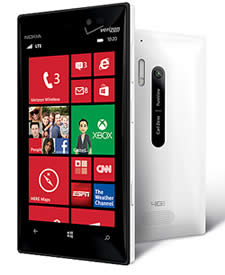Difference between Nokia Lumia 928 and iPhone 5
Key Difference: Nokia has recently announced a new phone to its line-up; the Lumia 928. The phone comes with a 4.5-inch AMOLED capacitive screen with broad back bezel. The phone is quite bulky and heavy, compared to other newer smartphones that are focusing on getting thinner and lighter. The iPhone 5 is the latest innovative product of the Apple Company. They have made the new phone slicker, thinner and lighter with even more packed features. iPhone 5 supports a 4-inch LED-backlit IPS LCD screen with 640 x 1136 pixels and 16 million colors. The phone also offers safety features such as corning gorilla class as well as oleophobic coating that keep fingerprints off the front screen.
 Nokia has recently announced a new phone to its line-up; the Lumia 928. This phone is considered as the flagship phone for Verizon (a US telecommunications company) but it is also available in an unlocked version. In terms of hardware, the phone is very similar to Nokia’s flagship 920 but has added on extra features and tweaks that can go either way. Although, the phone has been modified, there are no revisions to the Windows Phone 8.
Nokia has recently announced a new phone to its line-up; the Lumia 928. This phone is considered as the flagship phone for Verizon (a US telecommunications company) but it is also available in an unlocked version. In terms of hardware, the phone is very similar to Nokia’s flagship 920 but has added on extra features and tweaks that can go either way. Although, the phone has been modified, there are no revisions to the Windows Phone 8.
The Nokia Lumia 928 does not share the physical characteristics of the 920. It is in a bar from that has a slight bulge on the back that makes the phone comfortable to hold. Another small curve can be found on the bottom on which speaker grille is strategically placed that keeps volume from getting muffled when placed flat on the back. The phone comes with a 4.5-inch AMOLED capacitive screen with broad back bezel. The phone is quite bulky and heavy, compared to other newer smartphones that are focusing on getting thinner and lighter.
The Nokia phones are known for the bright interactive colors, which are no longer an option in this model. The phone is available only in two options: matte black and glossy white. This is believed to be because it is a Verizon exclusive phone. The phone comes with the basic structure of the Nokia phones with the volume rocker, power button and a dedicated camera key on the right edge. The power button is very similar to volume rocker only slightly smaller, making it difficult to find it without looking. The volume rocker is also a little to access and hit during mid-call. The left side of the device is bare, while the top hosts a center-mounted Micro USB port, a pull-out SIM tray and a 3.5mm jack. The back stands out with a bigger Xenon flash and the camera with Carl Zeiss lens.
The phone comes with a 4.5-inch AMOLED capacitive touchscreen with ~334 ppi pixel density and boasts excellent sunlight readability. The AMOLED screen is better for side viewing angles and sunlight visibility. The phone does have excellent resolution and the images are sharp, crisp and clear. The screen can also be configured for ‘high touch sensitivity’ known as ‘glove mode’. The phone also has amazing speakers but almost all reviewers said that when talking on the phone, the voice on the other end sounded hollow and unrealistic. The loud speaker also lacks bass and depth. However, the noise cancellation on the phone works exceptionally.
The phone is powered by 1.5 GHz Krait Dual-core Qualcomm MSM8960 Snapdragon processor, making it fast. The phone does not lag or even slow down. As it is a windows phone obviously it is powered by the Windows Phone 8 OS. The Android vs. Windows Phone debate is always the same. Though, the OS is great, Android does have more apps to offer and is also more customizable. The phones offers 1 GB RAM and has 32 GB internal memory. For users looking to add more than 32GB of data will run out of luck, as it does not offer adding extra memory.
The device houses an 8.7 MP PureView rear camera and a 1.2 MP front camera. The rear camera comes with the Carl Zeiss optics for sharper images. It also comes with the typical autofocus, image stabilization, flash etc. However, Nokia does proud itself for its low-light image technology and rightfully so. The low-light images are quite sharp and does not blur. In addition to that, the company also offers xenon flash that is bright and powerful. The xenon flash can only be used as flash and cannot be left lit, so the company has also added a secondary flash for videos and flashlight purposes. The camera does have slow shutter speed, which requires people to hold the camera still for long periods of time to avoid motion blur.
The device houses a non-removable Li-Ion 2000 mAh battery (BV 4-NW) that boasts good power. The Verge could run the battery for approximately 27 hours, while Tech Hive got only 6.5 hours out of it. The power of the battery depends on running applications, usage and many other different factors. In all, the phone is okay but does not come close to its 920 cousin.
 The Apple iPhone 5 is the successor to the company’s Apple smartphone flagship. It is one of the most popular products that have been constantly boosting the company’s sales. Though, Apple originally was assumed to have the most technologically innovative products, many other companies have stepped in to give it good competition.
The Apple iPhone 5 is the successor to the company’s Apple smartphone flagship. It is one of the most popular products that have been constantly boosting the company’s sales. Though, Apple originally was assumed to have the most technologically innovative products, many other companies have stepped in to give it good competition.
The iPhone 5 is the latest innovative product of the Apple Company. They have made the new phone slicker, thinner and lighter with even more packed features. Apple claims that the iPhone 5 is 18% thinner, 20% lighter, and has 12% less overall volume compared to the iPhone 4S. iPhone 5, bigger than its predecessors, supports a 4-inch LED-backlit IPS LCD screen with 640 x 1136 pixels and 16 million colors. The phone also offers safety features such as corning gorilla class as well as oleophobic coating that keep fingerprints off the front screen. iPhone 5 comes with the latest Apple iOS 6 that is upgradeable to 6.1. It includes a 1.2 GHz dual core Apple A6 processor, PowerVR SGX543MP3 and 1GB RAM. The phone is available with non-expandable 16, 32 or 64 GB internal storage capacity.
The problem with the new OS is that many features that work only with the iOS 6 do not work in certain territories and Apple has a rolling program that it said will take time to implement across more regions. The phone can also act as a hotspot and can share internet connection over WiFi, Bluetooth, or USB. Similar to the older versions, iPhone 5 is equipped with Siri that allows the user to operate the iPhone via vocal commands. However, Siri has been improved to and supports additional features such as being able to make restaurant reservations, launch apps, make twitter updates, search the internet for queries, etc. iOS 6 features several new and/or updated apps, which includes Apple Maps and Passbook. Apple Maps has also faced hostility as it does not execute properly and has also been known to give wrong directions. The Passbook app is able to retrieve documents such as boarding passes, admission tickets, coupons and loyalty cards. The phone also offers a new charging port, which is much smaller and more compact compared to the old chargers. They will also require a converter if you want to use them with the old charger, docks and other accessories. The phone has also shifted the headphone jack to the bottom of the phone.
The information for the detailed table about the two phones has been taken from the Nokia website, theverge.com, Apple website and GSMArena.com.
|
|
Nokia Lumia 928 |
iPhone 5 |
|
Launch Date |
May 2013 |
September 2012 |
|
Company |
Nokia |
Apple Corporation |
|
Size |
133 x 68.9 x 10.1 mm |
123.8 x 58.6 x 7.6 mm |
|
Display |
4.5-inch AMOLED capacitive touchscreen |
4.0 inches LED-backlit IPS LCD |
|
Screen |
768 x 1280 pixels (~334 ppi pixel density), 16 million colors |
640 x 1136 pixels, 16M colors |
|
Protection |
Corning Gorilla Glass 2 |
Corning Gorilla Glass, oleophobic coating |
|
Weight |
162 grams |
112 g |
|
2G Network |
GSM 850 / 900 / 1800 / 1900 CDMA 800 / 1900 |
GSM 850 / 900 / 1800 / 1900 - GSM A1428 CDMA 800 / 1900 / 2100 - CDMA A1429 |
|
3G Network |
HSDPA 850 / 900 / 1700 / 1900 / 2100 CDMA2000 1xEV-DO |
HSDPA 850 / 900 / 1900 / 2100 - GSM A1428 CDMA2000 1xEV-DO - CDMA A1429 |
|
4G Network |
LTE 700 MHz Class 13 / 1700 / 2100 |
LTE 700 MHz Class 17 / 1700 / 2100 - GSM A1428 or LTE 850 / 1800 / 2100 - GSM A1429 LTE 700 / 850 / 1800 / 1900 / 2100 - CDMA A1429 |
|
GUI |
Windows Phone UI |
IUI |
|
CPU speed |
1.5 GHz Krait Dual-core |
1.2 GHz dual core Apple A6 |
|
GPU |
Adreno 225 |
PowerVR SGX543MP3 |
|
OS |
Windows Phone 8 |
iOS 6, upgradable to iOS 6.1 |
|
Chipset |
Qualcomm MSM8960 Snapdragon |
Apple A6 |
|
RAM |
1 GB |
1 GB |
|
SIM Size |
microSIM |
nanoSIM |
|
Internal Memory |
32 GB |
16/32/64 GB |
|
Expandable Memory |
N/A |
No |
|
Sensors |
Ambient light sensor, Accelerometer, Gyroscope, Proximity sensor, Magnetometer |
Accelerometer, three-axis gyro, proximity, compass, ambient light sensor. |
|
Connectivity |
NFC, Wi-Fi Channel bonding,2G, 3G, 4G, Wi-Fi, USB and Bluetooth |
Bluetooth v4.0 with A2DP, Wi-Fi 802.11 a/b/g/n, dual-band, Wi-Fi hotspot, micro-USB v2.0. |
|
Data |
GPRS, EDGE, WLAN, Bluetooth, Wi-Fi, NFC, USB. |
GPRS, EDGE, WLAN, Bluetooth and USB. |
|
Speed |
EV-DO Rev. A, up to 3.1 Mbps; HSDPA, 42.2 Mbps; HSUPA, 5.76 Mbps; LTE, Cat3, 50 Mbps UL, 100 Mbps DL |
DC-HSDPA, 42 Mbps; HSDPA, 21 Mbps; HSUPA, 5.76 Mbps, LTE, 100 Mbps; EV-DO Rev. A, up to 3.1 Mbps |
|
WLAN |
WLAN IEEE 802.11 a/b/g/n |
Wi-Fi 802.11 a/b/g/n, dual-band, Wi-Fi hotspot |
|
Bluetooth |
Bluetooth v3.0 Object Push profile (OPP) 1.1, Hands-free profile (HFP) 1.5, Advanced Audio Distribution Profile (A2DP) 1.2, Audio/Video Remote Control Profile (AVRCP) 1.4, Phone Book Access Profile (PBAP) 1.1 |
Bluetooth 4.0 with A2DP |
|
USB |
microUSB 2.0 |
micro-USB 2.0. |
|
Primary Camera |
8.7 MP PureView 3264 x 2448 Pixels |
8 MP, 3264x2448 pixels, autofocus, LED flash, check quality |
|
Secondary Camera |
1.2 MP, 720p@30fps |
1.2 MP, 720p@30fps, face detection, FaceTime over Wi-Fi or Cellular |
|
Video |
1080p@30fps, video stabilization, stereo sound rec. |
1080p@30fps, LED video light, video stabilization, geo-tagging, check quality |
|
Camera Features |
|
|
|
Sound Enhancement |
Dolby Headphone sound enhancement Active noise cancellation with dedicated mic |
No |
|
Audio supported formats |
ASF, MP4, AAC, AMR, MP3, M4A, WMA, 3GP, 3G2 |
Audio formats supported: AAC (8 to 320 Kbps), Protected AAC, HE-AAC, MP3 (8 to 320 Kbps), MP3 VBR, Audible (formats 2, 3, 4, Audible Enhanced Audio, AAX, and AAX+), Apple Lossless, AIFF, and WAV |
|
Video supported formats |
MP4, WMV, AVI, 3GP, 3G2, M4V, MOV |
Video formats supported: H.264 video up to 1080p, 30 frames per second, High Profile level 4.1 with AAC-LC audio up to 160 Kbps, 48kHz, stereo audio in .m4v, .mp4, and .mov file formats; MPEG-4 video up to 2.5 Mbps, 640 by 480 pixels, 30 frames per second, Simple Profile with AAC-LC audio up to 160 Kbps per channel, 48kHz, stereo audio in .m4v, .mp4, and .mov file formats; Motion JPEG (M-JPEG) up to 35 Mbps, 1280 by 720 pixels, 30 frames per second, audio in ulaw, PCM stereo audio in .avi file format |
|
Battery Capacity |
Non-removable Li-Ion 2000 mAh battery (BV 4-NW) |
Non-removable Li-Po 1440 mAh battery |
|
Talktime |
2G: 11.8 hours 3G: 13 hours |
Up to 8 hours on 3G |
|
Standby Time |
2G: 606 hours 3G: 513 hours |
Up to 225 hours |
|
Available Colors |
Black, White |
Black & Slate and White & Silver. |
|
Messaging |
SMS (threaded view), MMS, Email, Push Email, IM |
iMessage, SMS (threaded view), MMS, Email, Push Email |
|
Browser |
HTML5 |
HTML (Safari) |
|
Radio |
N/A |
No |
|
GPS |
GPS with A-GPS support and GLONASS |
A-GPS support and GLONASS |
|
Java |
N/A |
No |
|
Additional Features |
|
|
Image Courtesy: nokia.com, spigen.com









Add new comment